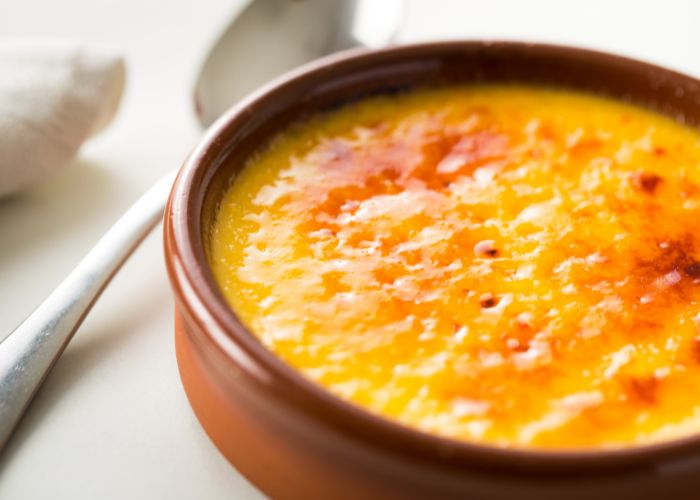CATALONIA – Catalan cuisine is known for its rich flavours and diverse range of ingredients, influenced by both Spanish and French culinary traditions. Food lovers will be blown away by some of these most popular dishes. In this article, we bring you a selection of dishes and desserts you can enjoy throughout Catalonia.
Food lovers everywhere should definitely visit Catalonia to experience its unique and diverse culinary traditions. Catalonia has a rich history of food culture, with influences from both Mediterranean and mountainous regions. The cuisine is characterised by its emphasis on fresh, high-quality ingredients, simple preparations, and bold flavours. From seafood paella and Crema Catalana to hearty Escudella i carn d’olla and savoury Botifarra amb mongetes, Catalonia’s cuisine is sure to satisfy any palate.
In addition to the food itself, Catalonia is also home to vibrant markets, local festivals, and wine regions that offer plenty of opportunities to sample and learn about the region’s culinary heritage. If you are in Barcelona, you must visit the Mercat de la Boqueria which claims to be the best in the world.
Overall, a trip to Catalonia is a must for food lovers looking to explore a rich and unique food culture.
Pa amb tomàquet
Also known as pan con tomate in Spanish, it is a traditional Catalan dish that is essentially bread rubbed with ripe tomatoes and drizzled with olive oil before being sprinkled with salt. The name “pa amb tomàquet” means “bread with tomato” in Catalan, and it is considered a staple of the region’s cuisine.
To make pa amb tomàquet, a ripe tomato is sliced in half and rubbed over a slice of toasted bread. The tomato flesh is gently pressed onto the bread to release its juices and flavour, and then a drizzle of olive oil and a sprinkle of salt may be added to enhance the taste. Some people may also add garlic or cured ham (jamón) to the dish, depending on their preferences.
Pa amb tomàquet is a simple yet delicious dish that is often eaten for breakfast, served as a snack or as an accompaniment to a main course. It is a popular dish in Catalonia and is enjoyed year-round, but especially during the summer months when tomatoes are in season and at their peak of flavour.
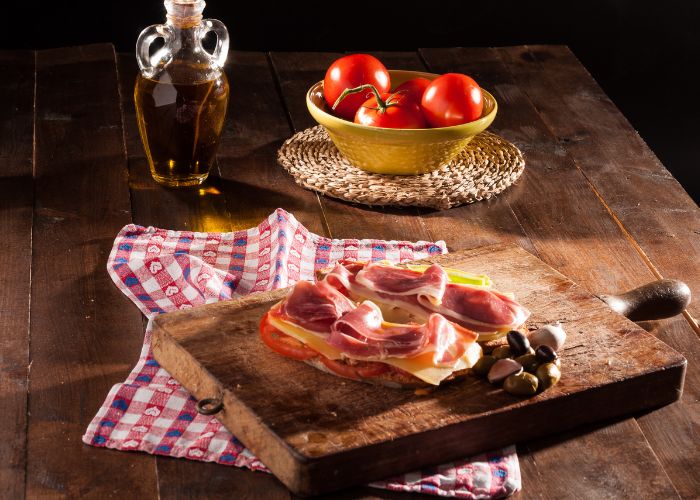
Excalivada
Escalivada is a traditional Catalan dish that consists of roasted vegetables that are typically served at room temperature. The name “escalivada” comes from the Catalan verb “escalivar,” which means “to roast over embers.” The dish is made by roasting vegetables, usually aubergine, red bell peppers, and onions, over an open flame or in the oven until they are tender and charred on the outside.
Once the vegetables are cooked, they are allowed to cool before being peeled and sliced into thin strips. The strips of vegetables are then seasoned with olive oil, garlic, salt, and pepper, and may be garnished with anchovies or olives. The dish is typically served with bread or crackers and may also be accompanied by cheese or cured meats.
Escalivada is a flavourful and healthy dish that is rich in vitamins and antioxidants. It is a popular dish in Catalonia, where it is often served as a tapa or appetizer, but it can also be served as a side dish or even as a main course. The dish is especially popular in the summer months when the vegetables are at their peak of flavour and freshness.
Escudella i carn d’olla
Escudella i carn d’olla is a traditional, hearty Catalan stew that is often served during the winter months and on special occasions. The dish has been a staple of Catalan cuisine for centuries and is considered a symbol of Catalan culture and identity.
The dish is typically made by simmering a variety of meats, such as beef, pork, and chicken, along with vegetables such as potatoes, carrots, and cabbage, in a large pot of water for several hours. The slow cooking process allows the flavours of the meats and vegetables to blend together, resulting in a rich and tasty broth.
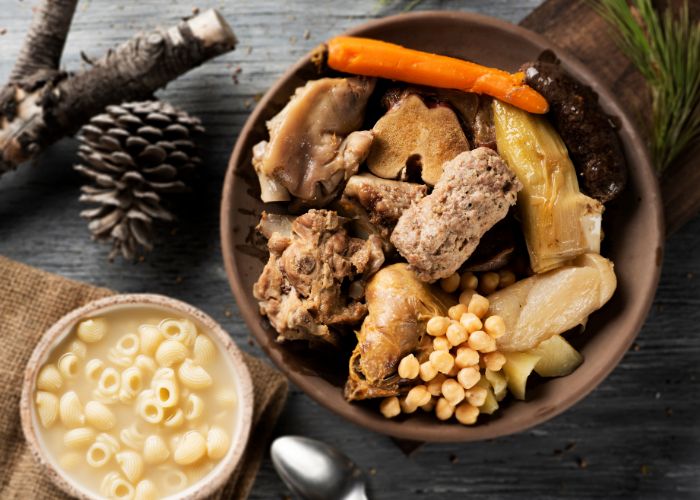
In addition to the meats and vegetables, the dish often includes other ingredients such as beans, rice, or noodles, depending on the region and the specific recipe. Some versions of the dish may also include sausages or other cured meats, as well as spices such as garlic, paprika, and bay leaves, to add extra flavor.
Escudella i carn d’olla is often served in two courses. The first course is the soup, which is typically served with a type of pasta called galets. The galets are hollow pasta shells that are large enough to be filled with meat or vegetables from the stew.
The second course of the dish is the meat and vegetables, which are typically served with a sauce called picada. Picada is made by grinding together toasted almonds, breadcrumbs, garlic, and parsley, and then adding it to the stew to thicken and flavour the broth.
Botifarra amb mongetes
A classic Catalan dish of highly seasoned, grilled sausage (Borifarra) served with white beans (mongetes). The sausage used in the dish is called is a traditional Catalan sausage made from ground pork, seasoned with salt, pepper, and other spices, and encased in natural pig intestine. However, it can come in many different varieties, with different seasonings and flavours depending on the region and the recipe.
The mongetes, or beans, used in the dish are usually white beans, such as the Catalan “mongeta del ganxet”, which is small and creamy. The beans are typically boiled until tender, and then served alongside the grilled or roasted botifarra sausage. The dish is often served with a side of allioli, a traditional Catalan garlic sauce made from garlic, olive oil, and salt. Botifarra amb mongetes is a simple, hearty, and delicious dish that is enjoyed throughout Catalonia.
Also read: Top 20 Spanish ‘horror’ dishes
The dish has its origins in rural Catalan cuisine, where it was a popular meal among farmers and rural communities. Today, it remains a beloved part of Catalan culinary heritage and is a great example of the region’s emphasis on using fresh, high-quality ingredients and simple, traditional preparations.
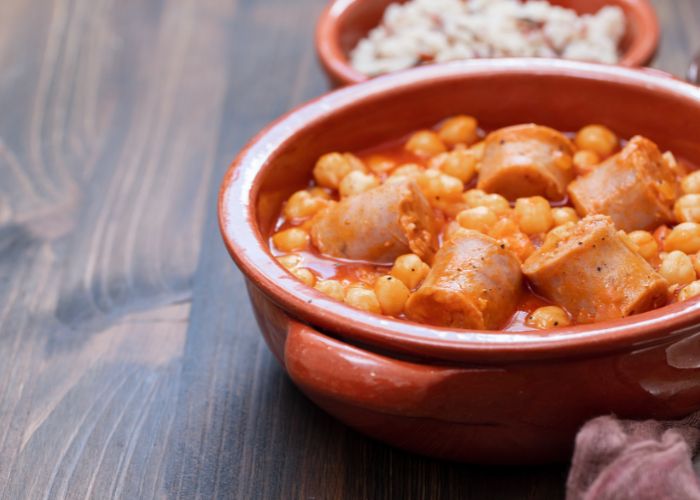
Calçots
Unique to Catalonia, these are a type of green onion eaten during the colder months of the year. Calçots are very sociable, as they tend to be charred on a BBQ or fire pit. Eating calçots is a long-standing tradition in Catalonia, and there are even festivals dedicated to them, called “calçotades.”
During a calçotada, people gather to grill calçots over an open flame until they are charred on the outside and tender on the inside. They are typically served with a special sauce called “romesco,” which is made from almonds, hazelnuts, red peppers, olive oil, garlic, and bread.
To eat a calçot, you typically hold it by the green leaves at the top and peel off the charred outer layer to reveal the tender, sweet inside. You then dip the calçot in the romesco sauce and eat it in one bite.
Calçotades are often held during the winter months, typically from January to March, and are a popular social event in Catalonia. They are a fun and tasty way to gather with friends and family to celebrate the winter season.

Fricandó de vedella amb bolets
Fricandó de Vedella amb Bolets is a traditional Catalan dish that is typically made with veal and mushrooms. The name “fricandó” comes from the French word “fricandeau,” which means a thin slice of meat that is usually braised.
Wild mushrooms are typically more abundant during the autumn months in Catalonia, and they are often used in the preparation of Fricandó de Vedella amb Bolets. The most used wild mushrooms for this dish are the “rovelló,” which is known in English as the saffron milk cap, and the “ceps,” which are known in English as porcini mushrooms.
During the autumn months, it is not uncommon to see markets in Catalonia selling a wide variety of wild mushrooms, including some that are highly prized for their flavour and texture. Many Catalans also enjoy foraging for wild mushrooms themselves, and it is considered a popular pastime in the region.
To make Fricandó de Vedella amb Bolets, the veal is typically sliced thinly and then seared in a pan until it is browned. It is then cooked in a sauce made from onions, garlic, tomatoes, red wine, and a mixture of spices such as cinnamon, cloves, and bay leaves. The mushrooms are added to the sauce towards the end of the cooking process, and the dish is typically served with a side of potatoes or rice.
Arrós negre
Arròs negre is a traditional rice dish that is popular in Catalonia, as well as in other parts of Spain, such as Valencia and the Balearic Islands. The name “arròs negre” means “black rice” in Catalan, and it gets its distinctive colour from the squid ink that is used to flavour and colour the dish.
To make arròs negre, a sofrito is typically prepared by sautéing onions, garlic, and tomatoes in olive oil. This is then combined with seafood such as squid, cuttlefish, or octopus, as well as other ingredients such as green peppers, paprika, and white wine. The squid ink is then added towards the end of the cooking process. This is what gives the dish its characteristic black colour.
Once the sofrito and seafood are cooked, short-grain rice is added to the pot along with fish or seafood broth. The rice is then cooked until it has absorbed all of the liquid and is tender, but still slightly al dente. Arròs negre is typically served with a slice of lemon and may be garnished with fresh herbs such as parsley or cilantro.
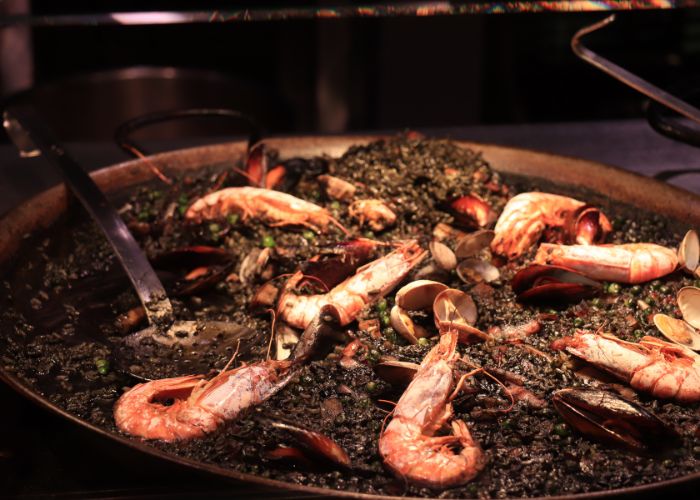
Exqueixada
Esqueixada is a traditional Catalan salad that is typically made with salt cod (bacalao), tomatoes, onions, peppers, and olives. The name “esqueixada” comes from the Catalan word “esqueixar,” which means “to shred,” and refers to the way in which the salt cod is prepared for the dish.
To make esqueixada, the salt cod is soaked in water to remove the salt and then shredded into small pieces by hand. The tomatoes, onions, and peppers are diced and mixed with the shredded cod, and then dressed with olive oil, vinegar, and salt to taste. The salad is typically garnished with black olives and parsley.
This is a refreshing dish bursting with flavour that is popular in the summer months in Catalonia, when temperatures can be quite warm. It is often served as a starter or appetizer but can also be eaten as a light main course. It is typically accompanied by crusty bread and a glass of wine or sparkling water.
Mel I mató
Mel i mató is a traditional Catalan dessert that consists of two main ingredients: fresh cheese and honey. The cheese used in this dessert is typically mató, which is a soft and creamy cheese made from cow or goat milk that is similar in texture to ricotta cheese. The cheese is sometimes mixed with a little sugar to sweeten it slightly.
To make mel i mató, a portion of fresh cheese is spooned onto a plate or into a bowl, and then drizzled generously with honey. The honey is usually a floral or fruity variety, such as orange blossom honey or lavender honey, to add extra flavor to the dish. Some versions of the dish may also include nuts or dried fruit as a garnish.
Mel i mató is a simple and delicious dessert that is popular throughout Catalonia. It is often served at the end of a meal as a sweet and satisfying finish, and it pairs well with a glass of sweet wine or a cup of coffee. The dish is also popular as a snack or breakfast item and can be found in bakeries and cafes throughout the region.
La Coca de Llardons
La Coca de Llardons is a traditional pastry from Catalonia that is typically consumed around Easter time. It is a savoury flatbread that is made with flour, water, yeast, and pork belly, which is known as llardons in Catalan.
To make the coca de llardons, the pork belly is first fried until it is crispy and then chopped into small pieces. The dough is then rolled out into a flat disc shape and topped with the chopped llardons, along with other savoury ingredients such as onions, peppers, and sometimes anchovies. The pastry is then baked in the oven until golden brown and crispy.
La Coca de Llardons has a special significance during Easter time in Catalonia, where it is often consumed as part of the Easter Monday tradition known as “La Mona de Pasqua.” This tradition involves giving a special pastry or cake to children as a gift on the day after Easter Sunday, and the Coca de Llardons is a popular choice for this occasion.
Also read: The history and traditions of Semana Santa in Spain
Crema Catalana
Crema Catalana is a traditional dessert from Catalonia that is similar to crème brûlée. It is made by heating milk, cream, sugar, and lemon or orange peel on the stove until the mixture is thickened and then tempered with egg yolks. The mixture is then poured into individual ramekins or a large shallow dish and chilled until set.
Just before serving, a thin layer of sugar is sprinkled on top of each custard and then caramelised with a kitchen torch or under a broiler until it forms a crispy golden brown crust. The result is a deliciously creamy and smooth custard with a satisfying crunch from the caramelised sugar.
The origins of Crema Catalana can be traced back to the Middle Ages, where it was known as “crema de Sant Josep” and was traditionally eaten on the Feast of St. Joseph, which falls on March 19th. Over time, the recipe evolved and became a popular dessert throughout Catalonia.
